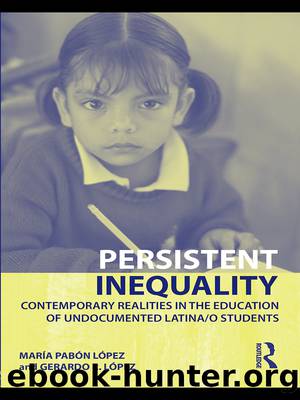Persistent Inequality by Pabon Lopez Maria;Lopez Gerardo R.; & Gerardo R. López

Author:Pabon Lopez, Maria;Lopez, Gerardo R.; & Gerardo R. López
Language: eng
Format: epub
Tags: Education
Publisher: Taylor & Francis Group
Published: 2009-11-19T00:00:00+00:00
While NCLB does allow for testing accommodations that could result in a more accurate assessment of an LEP studentâs academic ability (e.g., offering a test in the studentâs native language, using alternative tests that cover the same material but are less English language-dependent, allowing LEP students to use bilingual language dictionaries during tests),49 such accommodations vary on a state-by-state basis and are less likely to be found in Midwestern and other non-traditional receiving states where the most recent immigration growth has occurred.50 In other words, states that need these accommodations the most are the least likely to offer them, placing marginalized students in these states at higher risk of not passing the state test.
Another disadvantage for immigrant and LEP students is the NCLB requirement for students to be taught by highly qualified teachers. While NCLB âdoes not require current teachers to return to school or get a degree in every subject they teach to demonstrate that they are highly qualified,â51 it does require that every core content teacher be highly qualified. Consequently, teachers who work with LEP children do not need to be âcertifiedâ bilingual or ESL teachers, nor do they need to demonstrate knowledge of how to work with LEP students in their classrooms on an everyday basis; they only need meet the highly qualified criteria for the subject area in which they teach.
Clearly, this puts LEP students at a disadvantageâfor these students might be tracked into ESL classrooms with teachers or paraprofessionals who are not highly qualified52 or they might be taught a core academic subject by someone who is working in a consultative capacity to a regular content teacher. In the latter case, the bilingual teacher or paraprofessional who provides language assistance to LEP students is not recognized as the individual delivering the primary content instruction; therefore, the bilingual assistant does not need to meet the highly qualified criteria as defined by the state.
As such, it is quite possible for LEP studentsâparticularly those who are at the earlier levels of English language proficiencyâto receive the majority of their core content instruction in their native language from individuals who are not highly qualified in any particular subject area.53 In short, the LEP student not only has to learn the subject matter from individuals who may not be qualified or trained to address their linguistic and pedagogical needs, but they are also expected to take the content area assessment along with the rest of their peers in a language they may not understand, perhaps without additional accommodations, and still perform to a particular pre-designated standard.54
NCLB does allow a one-year grace period before a ârecently arrivedâ LEP student can be tested in reading/language arts.55 Recently arrived students are those who have attended schools in the U.S. for less than twelve months. The law gives this grace period to schools and districts to avoid testing LEP students in such a language-heavy content area. It is up to the school and the district to determine whether or not they exercise this exemption or test the student in the first year.
Download
This site does not store any files on its server. We only index and link to content provided by other sites. Please contact the content providers to delete copyright contents if any and email us, we'll remove relevant links or contents immediately.
| Anthropology | Archaeology |
| Philosophy | Politics & Government |
| Social Sciences | Sociology |
| Women's Studies |
Cecilia; Or, Memoirs of an Heiress — Volume 1 by Fanny Burney(32075)
Cecilia; Or, Memoirs of an Heiress — Volume 3 by Fanny Burney(31469)
Cecilia; Or, Memoirs of an Heiress — Volume 2 by Fanny Burney(31419)
The Great Music City by Andrea Baker(30797)
We're Going to Need More Wine by Gabrielle Union(18641)
All the Missing Girls by Megan Miranda(14788)
Pimp by Iceberg Slim(13798)
Bombshells: Glamour Girls of a Lifetime by Sullivan Steve(13698)
Fifty Shades Freed by E L James(12925)
Talking to Strangers by Malcolm Gladwell(12888)
Norse Mythology by Gaiman Neil(12861)
For the Love of Europe by Rick Steves(11558)
Crazy Rich Asians by Kevin Kwan(8898)
Mindhunter: Inside the FBI's Elite Serial Crime Unit by John E. Douglas & Mark Olshaker(8721)
The Lost Art of Listening by Michael P. Nichols(7170)
Enlightenment Now: The Case for Reason, Science, Humanism, and Progress by Steven Pinker(6879)
The Four Agreements by Don Miguel Ruiz(6326)
Bad Blood by John Carreyrou(6284)
Weapons of Math Destruction by Cathy O'Neil(5846)
